#hws ryukyu islands
Explore tagged Tumblr posts
Text
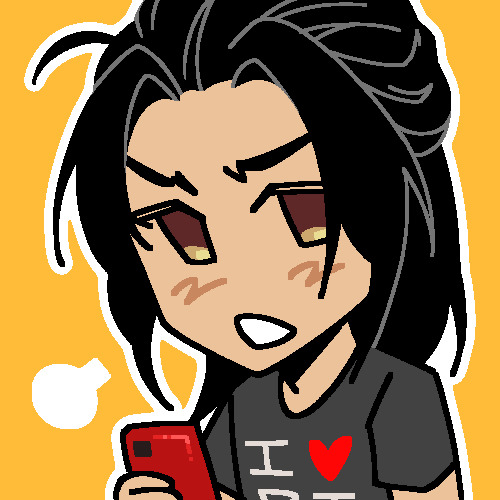

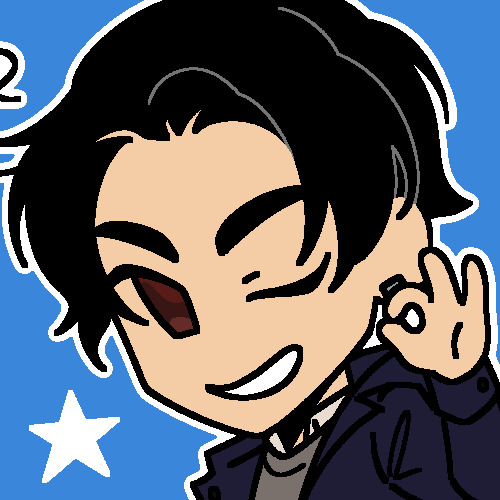

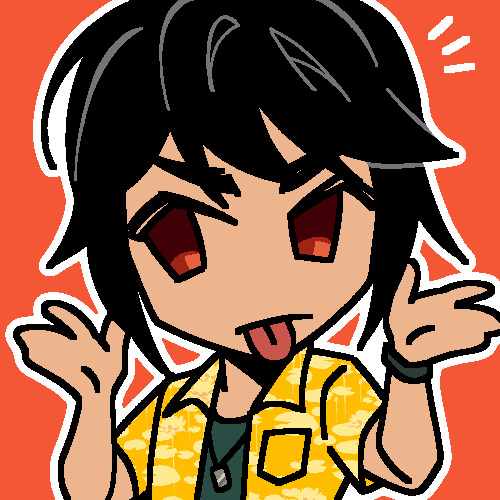
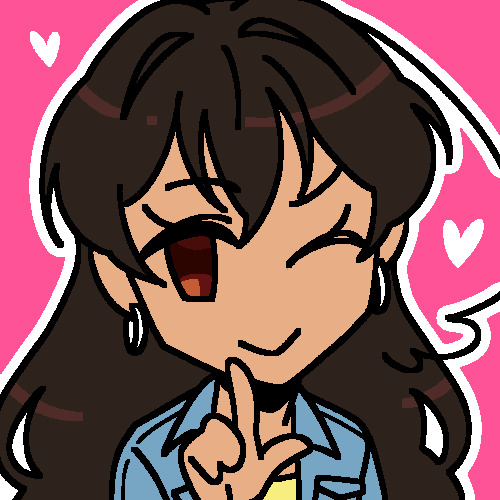




east asia pfps WTF!!!
left to right, top to bottom (minnan belongs to @luyous and north korea belongs to @itstokkii)
China
Japan
South Korea
North Korea
Hong Kong
Taiwan
Macau
Ryukyu/Okinawa
Ainu
Minnan/Quanzhou
#hetalia#hetalia ocs#historically inaccurate hair is historically inaccurate#cd pfps#aph china#aph north korea#aph japan#aph south korea#aph hong kong#aph taiwan#aph macau#aph ryukyu islands#aph okinawa#aph ainu#aph minnan#hws china#hws japan#hws south korea#hws north korea#hws hong kong#hws taiwan#hws macau#hws ryukyu islands#hws okinawa#hws ainu#hws minnan#hws quanzhou
278 notes
·
View notes
Note
Hello, I got a question that might peak your interest. Do you have Headcanons about the Ainu people of Japan?
not many, but here's some! (@aphasiaweek for Day 9 Japan bashing)
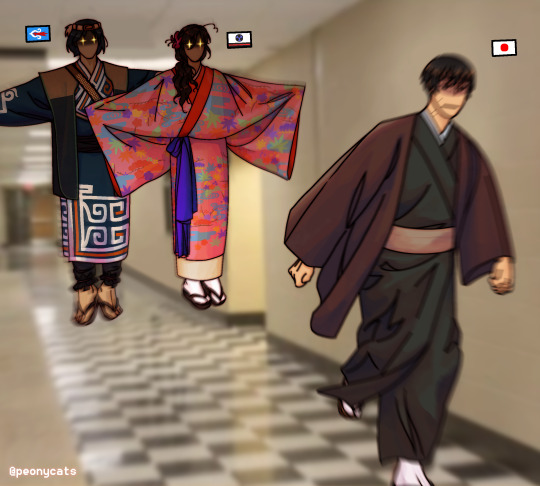
bffs with Miss Ryukyu Islands and friends with Miss Sápmi
had a (series of) pet bear(s) back in the day
used to have a beard
Manages to even out "old-man" Japan
Very tired
Doesn't really like Russia
Used to not like Mongolia but it's been 500 years so they're like ok now
and have Miss Ryukyu/Okinawa and Ainu banging out some tunes! Ryukyu is playing a sanshin, and Ainu is playing a tonkori, both instruments played among their respective culture~
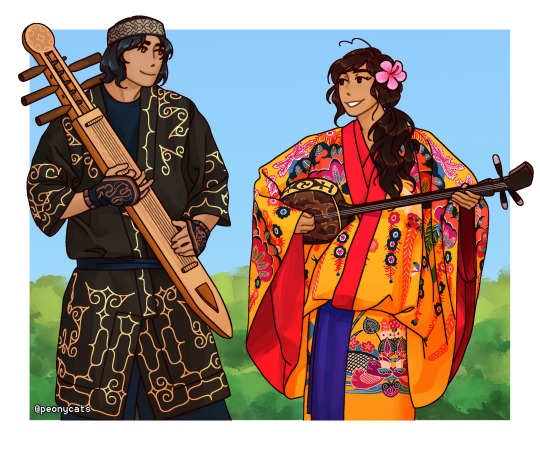
Historical Footnotes:
// discussions of genocide and culture suppression
The Ryukyuan Kingdom, existing from 1429 to 1879, was a tributary state of China and played an important role in maritime trade between East Asia and Southeast Asia. It became a vassal of Japan in 1609, but remained technically independent until 1872, when it became the Okinawa prefecture. Ryukyuan culture was suppressed under Japanese rule, and to this day, the people of Okinawa fight against the concentration of US military bases in their lands and for the preservation of their native culture and language.
The Ryukyuan equivalent to the kimono is the ryusou, which Miss Ryukyu/Okinawa is wearing here. It's not nearly as complicated in components, and its fit is much looser. In a Japanese kimono, the obi is always tied in the back, while it can be tied with a bow in the front for ryusou. It's commonly dyed using the bingata technique!
Bingata is an dyeing technique unique to the Ryukyuan islands. It's well known for its vibrant colors and elaborate designs, and is applied to the cloth through a pattern stencil.
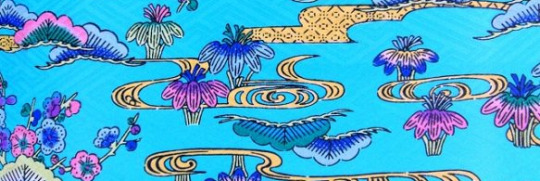
The Ainu are the indigenous people of Hokkaido, Sakhalin, and Kuril Islands. Following the Sengoku period, the Ainu slowly became more and more dependent on Japan and Japanese goods, despite many rebellions against this Japanese domination. In 1806, fearing that Russia would attempt to spread its influence to its northern lands, Japan took direct control of Hokkaido and began to assimilate the Ainu into mainstream Japanese society. Ainu men were forced into servitude and only fed and clothed if they gave up their language and culture, and Ainu women were forcibly married to Japanese men; many Ainu cultural practices were also banned under Imperial Japan. This greatly reduced the Ainu's numbers, and unlike the Ryukyuans, the Ainu today are a minority in Hokkaido, and many Japanese remain unaware of their Ainu heritage. Ainu continue to suffer from lower economic prosperity compared to their Yamato Japanese counterparts, even to this day.
Toward the end of the 20th century, Ainu activism and revitalization movements began to rise in prominence, and a number of legal reforms protecting Ainu culture have been passed in the following years. In 2008, the Japanese government officially recognized them as a minority, and in 2019, a bill was passed recognizing them officially as the indigenous people of Japan.
Mister Ainu is wearing an attus, which is a coat-like garment. It's made from the fibers of an elm tree native to Hokkaido. The process of extracting fibers and processing them for fabric use is quite time consuming! Typically, ceremonial attus were decorated with elaborate geometric patterns and applique. It was thought that the embroidered patterns could protect from evil.
In the first picture, Mister Ainu is wearing a sapanupe, a traditional crown made from grape vines, wood shavings, and carvings of sacred animals. They were worn for important occasions but also helped keep men's hair tidy.
On the Mongolia note: In the 1200s, the Ainu expanded into the island of Sakhalin, putting them into conflict with the Nivk people, who had submitted to the Yuan dynasty. The Sakhalin Ainu fought the combined forces of the Yuan Dynasty for 40 years, but eventually surrendered and became tributaries of the Khan.
On the Sápmi note: Since 2011, the Ainu have done cultural exchange and cooperation with the Sámi. Both the Sami and Ainu participate in the organization for Arctic Indigenous people.
Tonkori: A plucked string instrument played by the Ainu and generally has five strings.
Sanshin: An instrument unique to the Okinawan and Amami islands; it has three strings and has a snakeskin covered body. It's believed that it was influenced by the Chinese sanxian, as the Ryukyuan kingdom held very close ties to Imperial China. When the sanshin reached mainland Japan, it evolved into the larger shamisen.
YES I KNOW JAPAN'S KIMONO FOLD IS ON THE WRONG SIDE the reference i was using for him had the kimono fold on the wrong side but i figured since the left over right fold was only used for corpses it was appropriate since clearly this is japan 5 seconds before disaster strikes
#hws ainu#hws ryukyu islands#hws okinawa#hws japan#aph japan#hetalia#ask#anonymous#hetalia headcanons#ryukyu and ainu have a similar relationship to hawaii and alaska#historically had nothing to do w each other but united in the 'getting royally fucked over by the central govt and colonialism' department#historically inaccurate hair is historically inaccurate#aphasiaweek#tw genocide#aph ainu#aph okinawa#aph ryukyu islands
205 notes
·
View notes